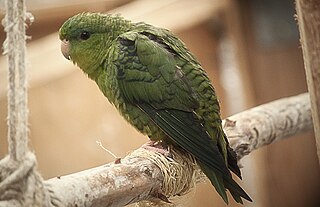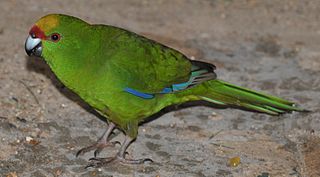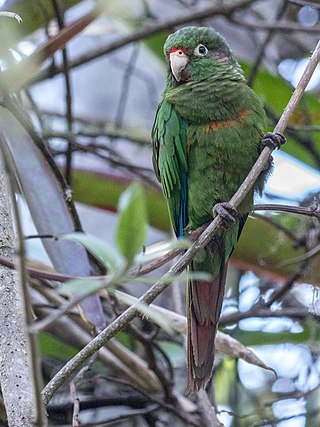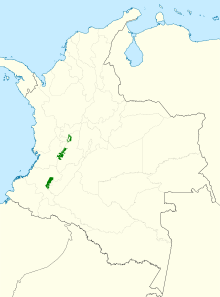
The Nicobar parakeet, also known as the Blyth's parakeet, is a parrot in the genus Psittacula, endemic to the Nicobar Islands of the Indian Ocean. It is one of the largest parakeets, measuring 56 to 60 cm from the top of the head to the tip of the tail and weighing about 224 g.

The barred parakeet, also known as the lineolated parakeet or the Catherine parakeet, is a small parrot found disjunctly in highland forests from southern Mexico to Panama, in the Andes from western Venezuela to southern Peru and Bolivia, the Santa Marta Mountains in Colombia and the Venezuelan Coastal Range. Its plumage is mostly green with multiple black and dark green stripes or bars, and it has a pale-horn coloured beak. The dark stripes vary in prominence between its two subspecies. Several colour mutants are available in aviculture.

The yellow-crowned parakeet also known as the yellow-fronted parakeet is a species of parakeet endemic to the islands of New Zealand. The species is found across the main three islands of New Zealand, North Island, South Island and Stewart Island/Rakiura, as well as on the subantarctic Auckland Islands. It has declined due to predation from introduced species such as stoats, although unlike the red-crowned parakeet, it has not been extirpated from the mainland of New Zealand. Its Māori name is kākāriki.

The New Caledonian lorikeet is a potentially extinct lorikeet endemic to the Melanesian island of New Caledonia.

The Tropical Andes is northern of the three climate-delineated parts of the Andes, the others being the Dry Andes and the Wet Andes. The Tropical Andes' area spans 1,542,644 km2 (595,618 sq mi).

The Andean parakeet is a species of bird in subfamily Arinae of the family Psittacidae, the African and New World parrots. It is found in Argentina, Bolivia, and Peru.

The blue-headed racket-tail, also known as the Palawan racket-tail and locally as kinawihan, is a parrot found in the western Philippines around Palawan. The species was formerly considered conspecific with the blue-crowned racket-tail. It is locally known as 'kilit'. It inhabits humid lowland forest in small flocks. It is threatened by habitat destruction and limited trapping for the cage-bird trade.

The plain parakeet is a species of bird in subfamily Arinae of the family Psittacidae, the African and New World parrots. It is endemic to Brazil.

The golden-plumed parakeet is a Neotropical parrot species within the family Psittacidae, belonging to the monotypic genus Leptosittaca. This somewhat Aratinga-like species is found in humid temperate highland forests, especially with Podocarpus, on the east Andean slope in Colombia, Ecuador, and Peru. It is generally local and uncommon. It is threatened by habitat loss. Clearing of high-altitude forests for agricultural reasons have greatly impacted the loss of habitat for this parakeet species. Further reduction of such habitats will continue to diminish the number of golden-plumed parakeets left in South America. It is the only known parakeet species that can detect ultraviolet radiation.

The mountain parakeet, also known as the golden-fronted parakeet, is a species of parrot, one of two in the genus Psilopsiagon within the family Psittacidae. It is found in the Puna grassland. Its natural habitat is subtropical or tropical high-altitude shrubland. Four subspecies are recognised.

The grey-hooded parakeet, also known as the Aymara parakeet or Sierra parakeet, is a species of parrot in the family Psittacidae. It is found in northwestern Argentina and Bolivia. Its natural habitat is subtropical or tropical high-altitude shrubland.

The white-breasted parakeet or white-necked parakeet is a Vulnerable species of bird in subfamily Arinae of the family Psittacidae, the African and New World parrots. It is found in southern Ecuador and possibly in adjacent northern Peru.

The flame-winged parakeet, also known as the brown-breasted parakeet, is a species of parrot in the family Psittacidae. It is endemic to forest edge and shrub at altitudes of 1,700–3,400 m (5,600–11,200 ft) above sea level on the east Andean slope in Colombia. It is threatened by habitat loss.

The fiery-shouldered parakeet, also known as the fiery-shouldered conure, is a species of parrot in the family Psittacidae. It is found in Brazil, Guyana, and Venezuela. Its natural habitat is subtropical or tropical moist montane forests. There are two subspecies, P. e. egregia and P. e. obscura.

The Santa Marta parakeet is an Endangered species of bird in subfamily Arinae of the family Psittacidae, the African and New World parrots. It is endemic to Colombia.

The chestnut-bellied flowerpiercer is a species of bird in the family Thraupidae. It is endemic to Colombia.

The Santa Marta páramo (NT1007) is an ecoregion containing páramo vegetation above the treeline in the Sierra Nevada de Santa Marta mountain range on the Caribbean coast of Colombia. The isolated position of the range has allowed unique species to evolve. Some are related to those found in Central America and the Caribbean coastal areas, and some to species from the Andes. The habitat is relatively stable, but has been drastically changed from the original by long-term human activity.

The Cordillera Central páramo (NT1004) is an ecoregion containing páramo vegetation above the treeline in the Andes mountain range of northern Peru and southern Ecuador. Due to its isolation there are high levels of endemism. Despite many human settlements and some destruction of habitat by agriculture and mining, the ecoregion is relatively intact.

The Venezuelan Andes montane forests (NT0175) is an ecoregion in the northern arm of the Andes in Venezuela. It contains montane and cloud forests, reaching up to the high-level Cordillera de Merida páramo high moor ecoregion. The forests are home to many endemic species of flora and fauna. Their lower levels are threatened by migrant farmers, who clear patches of forest to grow crops, then move on.





















